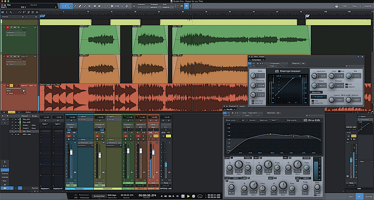Why Your Mix Matters More Than You Think Your mix holds your track together, and even the best...
Why Your Track Sounds Great in the Studio but Falls Flat in the Club
The Studio Sound vs. The Club Reality: Setting the Stage
You’ve spent hours crafting the perfect track. In the studio, every sound feels rich, every beat strikes deep, and every detail shines. But when your masterpiece hits the club, something’s off. It doesn’t translate the way you imagined. The energy falls flat. What happened?
The reality is that a track that sounds flawless in a studio environment can feel lackluster in a club. The reason? The vast differences between the two settings. Studios are precision-engineered spaces optimized for pristine sound quality with controlled acoustics, high-end gear, and a quiet, solitary vibe. Clubs are chaotic, energetic, and loud. The acoustics of a cavernous, packed space with reverberating walls and a roaring crowd can wreak havoc on your carefully balanced mix.
The question isn't just "why" this happens—it’s what you can do about it.

The Influence of Acoustics: How Rooms Change Your Sound
In the studio, you're sitting in the sweet spot. You know that precise point where the sound is balanced, enveloping you in clarity and nuance. The walls are treated to absorb reflections, the monitors are tuned to perfection, and every sound feels intimate and controlled. That’s why your track sounds so immaculate.
Then there’s the club. Enter echoes, hard surfaces, and unpredictable sound waves. Clubs are notorious for their acoustic challenges: sound bounces unpredictably, crowd noise distorts your pristine mix, and low frequencies either flood the room or get swallowed up in the din. What felt tight and punchy in the studio now feels like competing with the venue itself. Instead of hearing those intricate layers, your audience is overwhelmed by muddiness.
To fix this, you need to be mindful of how your track will interact with different spaces. This starts with understanding the specific challenges of the environment you're mixing for.
Bass and Sub-Bass: The Foundation of Club Sound
Your track’s bass line was booming in the studio, but in the club, it disappears into the ether. This is a classic problem. Bass and sub-bass are the foundations of club music, and if they aren’t dialed in perfectly, they either vanish or become a mess of thumping with no definition.
Club systems are built for power. Massive subs deliver seismic lows, but only when your mix is designed to take full advantage of it. Studio monitors—while accurate—don’t always reproduce the kind of deep, chest-rattling sub-bass that defines the club experience. To make your bass hit right in a large venue, you need to master the low end carefully, focusing on both clarity and impact.
The key is to strike a balance between depth and control. Too much sub-bass and your track will overwhelm the room. Too little, and it’ll disappear in the sea of low-end frequencies. Techniques like high-pass filtering and careful EQ can help ensure that your bassline remains powerful but defined.
Volume Wars: Loudness in the Club vs. Loudness in the Studio
In the studio, the temptation is to crank up the volume. After all, louder feels better, right? The psychology of loudness plays tricks on us: louder tracks often seem more powerful and more dynamic. But the truth is the louder your track in the studio, the more it risks falling apart in the club.
In a club, volume is a completely different game. Clubs are loud, sometimes ear-splittingly so, but the dynamic range matters more. A track that’s overly compressed and cranked up to eleven will lose its punch in the club. Dynamics create contrast—quiet moments make the loud moments hit even harder. So, instead of pushing everything to the limit in the studio, focus on preserving the dynamic range that will allow your track to breathe and come alive on the dance floor.
Midrange Magic: The Key to Cutting Through in the Club
Producers often focus on the extremes—the booming lows, the crisp highs—but forget about the unsung hero of a great mix: the midrange. It’s the midrange frequencies that carry the warmth, the groove, and the melody. These frequencies are often underappreciated in a studio environment, but they are essential for ensuring your track cuts through the noise in a packed club.
Clubs are noisy and filled with layers of sound that your mix has to compete with. Midrange frequencies—the ones that sit between 300Hz and 5kHz—are where the human ear is most sensitive. These are the frequencies that will help your track stand out against the chaos. If your mids are too weak, your track will be drowned out by everything else. Shape them carefully, give them presence, and make sure they can hold their own in a crowded sonic space.
The Art of Mastering for Multiple Environments
One size never fits all, especially when it comes to mastering. The mastering process isn’t just about making your track sound good—it’s about making it sound good everywhere. Headphones, car stereos, home speakers, and club sound systems all treat sound differently.
To truly make your track versatile, adaptive mastering techniques are essential. What works on headphones might not hit the same in a club. Mastering for multiple environments requires a deep understanding of how different systems handle frequency response, stereo imaging, and dynamics. This involves creating a mix that retains its impact no matter where it’s played—whether it’s in someone’s living room or through towering stacks of club speakers.
Real-World Testing: How to Simulate the Club Sound Without Leaving Your Studio
You don’t need a club to test your mix—there are plenty of ways to mimic that environment right in your studio. The first rule? Test your track on as many different systems as you can. Play it in your car, on low-end speakers, on your phone’s tinny speaker. Each setup will expose different aspects of your mix, helping you identify areas that need tweaking.
Want to get even closer to a club environment? Crank up the volume in a large, untreated room. You’ll hear how the bass reverberates, how the mids struggle to push through, and how different frequencies interact in an open space. While it’s not perfect, it’ll give you a much clearer sense of how your track might behave in a real venue.
When It’s Time to Call in the Pros: How a Mastering Engineer Can Help
Sometimes, you’ve done all you can. That’s when it’s time to call in a professional mastering engineer. A seasoned engineer knows exactly how to tailor your track for various listening environments. They have the tools and the expertise to elevate your track from good to great, ensuring that it holds up under the unique demands of a club system.
Mastering isn’t just about making your track louder—it’s about enhancing its depth, punch, and clarity across all environments. When you find the right engineer who understands your sound and vision, they can make the difference between a track that falls flat and one that leaves the crowd wanting more.
Wrap-Up: Turn Studio Perfection into Club Success
Your track may sound pristine in the studio, but to truly resonate in the club, you have to think beyond the studio walls. Pay attention to acoustics, master your low-end, and make sure your mids shine. Above all, be mindful of how different environments will treat your mix. Don’t be afraid to test, tweak, and test again. The goal is to create something that translates effortlessly from headphones to the club—and when you do, you’ll feel the difference.
Remember, it’s a process. But it’s a process worth mastering.
.png?width=200&height=84&name=brandmark-design%20(2).png)



